Back in September 2022, I hiked the Salkantay route to visit Machu Picchu. I also spent over a month in Cusco.
In this article, I've compiled the most up-to-date and comprehensive information on the Salkantay trek based on my own experience and extensive research.
I've included guidance on the route, costs, the tour operators, how to do the Salkantay without a guide, when to go and much more.
Let's jump in.
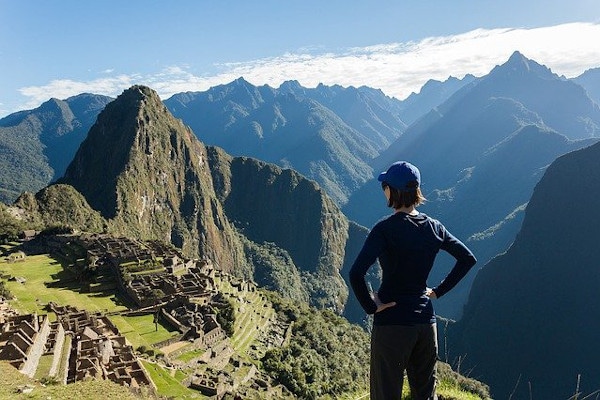
Get a Salkantay trek quote
Start planning your Machu Picchu hiking holiday.
Salkantay Trek to Machu Picchu - One of the World's Best Hikes
A Brief Overview of the Salkantay Trek
The Salkantay trek (also known as the Salkantay trail) is the most popular alternative trek to Machu Picchu. And with good reason - it offers hikers an incredibly diverse trekking experience.
National Geographic Adventure Magazine rated the Salkantay trek as one of the 25 Best Treks in the World.
The trail is relatively easy to access from Cusco. Unlike the Inca Trail, there are no permit limitations. In fact, the Salkantay trek can be completed without the use of a guide or tour agency.
See more in our guide on how to do the Salkantay Trek unguided.
The trail journeys through incredible landscapes with lowland jungle giving way to highland alpine settings and glaciated mountains.
See our handy route map below outlining the various checkpoints along the Salkantay trek.
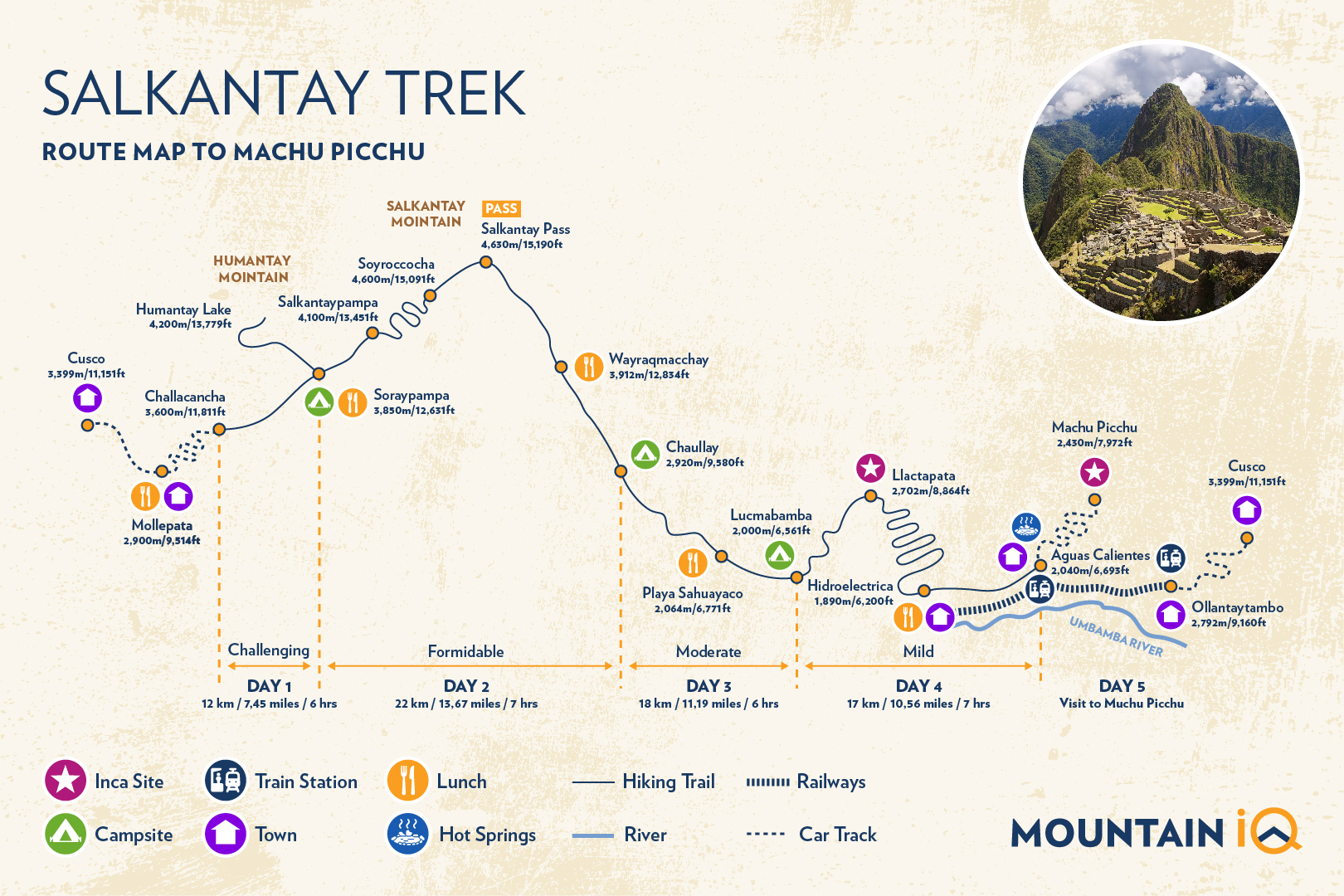
How long is the Salkantay Trek?
The Salkantay Trek is approximately 69 kilometres / 42.87 miles long. There are some variations on route depending on where you start and the company you trek with.
The trek is typically completed on a 5 Day / 4 Night itinerary with a visit to Machu Picchu on the fifth and final day. However, it is possible to do the trek on a 4 Day / 3 Night itinerary too.
You can also combine the Salkantay trek with the Inca Trail for a challenging, 7-day hike.
Looking for a day tour? Here are my 5 favourite day tours around Cusco:
- Rainbow Mountain day trip (with meals)
- Moray and Salt Mines Quad Bike Tour
- Sacred Valley day tour
- Humantay Lake day tour
- Machu Picchu and Huayna Picchu entrance tickets
See more Cusco day trips.
Is the Salkantay Trek Difficult?
The Salkantay trek is not too difficult and considered a long hike with some moderate to challenging ascents. The Salkantay trail is generally said to be more difficult than the 4-day Inca Trail since it is almost twice the distance.
After hiking the Salkantay, I would say it is not especially challenging. There are no technical parts and only two long uphill climbs. Many of the days include long sections trekking downslope.
With that said, you will need to be physically fit to take on this hike. Some form of training is necessary (see more in our section on training and preparation below).
I would also suggest you first take on some tough day trails (more than 15km / 9 miles) and shorter overnight hikes. Huaraz in North Peru is a great place to prepare for the Salkantay trek.
The most difficult part of the Salkantay trek is on Day 2. This is when you ascend the pass to Salkantay Mountain (6,271m / 20,574 ft). During this part of the trek, make sure you drink plenty of water and stop often to catch your breath.
Day 4 is another long day with a steep hike in the morning. I found the 2-hour descent to Hidroeléctrica (1,890m / 6,200 ft) to be particularly tough on my knees. Take it slow and walk in small zigzags down the path.
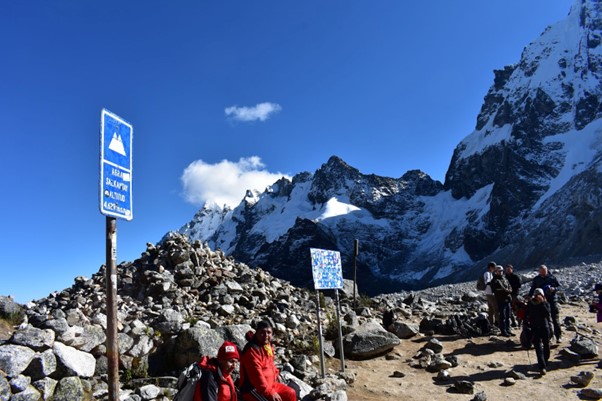
Day 2 of the Salkantay Trek - The top of Salkantay pass.
What Makes Salkantay Mountain Special?
What makes Sakantay trek special is its most notable landmark - Mount Salkantay, for which the trail is named.
Mount Salkantay (or Nevada Salkantay / Salcantay) is the most iconic mountain near Cusco. It is also the highest mountain in the Willkapampa range.
Trekkers on the Salkantay trail approach the mountain from the south. On the first night, you can sometimes hear avalanches from camp in the valley below this snowy summit.
On the second day, hikers scale the Salkantay Pass (4,630m / 15,190 ft). At the top of this pass, you will be in close proximity to the mountain. This altitude also provides amazing views into the valley below.
This mountain is held sacred within Peruvian culture. It is not easily scaled and there have been few summit expeditions.
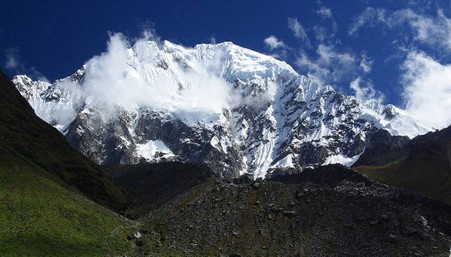
South-west face of Nevada Salkantay, as viewed from the Salkantay trail.
What Is the Salkantay Trek Itinerary?
The Salkantay trek set out below is for a typical 5 Day / 4 Night itinerary using an official tour company. With these treks, arrieros (horsemen) are employed to carry gear for hikers.
This route is the most common. You may see some variations from tour company to tour company.
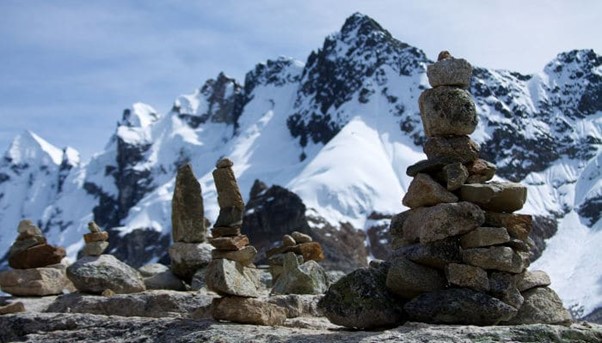
Stone Cairns left by previous trekkers at the Salkantay Pass (4,600m / 15,092 ft).
Day 1: Cusco - Mollepata - Soraypampa
- Total trek distance: ~12km / 7.45 miles
- Total time walking: ~6 hours
Most Salkantay tours depart by bus or private car from Cusco city (3,399m / 11,151 ft) early on day one. You will be picked up from your hotel or meet at the company office around 4:30 / 5:00.
From Cusco, it is a 2-hour drive to the town of Mollepata (2,900m / 9,514 ft). Here is the first checkpoint where you will need to pay Salkantay entrance fees (which costs about 20 soles). This money goes directly to the community. In Mollepata, you will likely stop and have breakfast.
It is possible to start the trek from Mollepata but most tour operators don’t. This is because this lengthens day one by a few hours. Also, the beginning of the trail is along a rather unpleasant road.
Most operators will take you to the trailhead at Challacancha (3,600m / 11,811 ft). You may also start slightly further on at Sayllapata. Both these start points are around 3,600m (11,811 ft) above sea level.
From here, trekkers follow a gradual trail that climbs upwards. It takes about 3-4 hours to reach Soraypampa (3,850m / 12,631 ft).
Soraypampa is where you will meet your support team. The first good views of Salkantay and the Apurimac River valley are visible from here.
This is where most trekking groups will stop to have lunch. After lunch, you may trek up to Humantay Lake situated at 4,200m / 13,779 ft (1.5 hours up the pass) before returning to Soraypampa to camp for the night.
Alternatively, some companies start from Soraypampa Camp (3850m / 12,631 ft). In this case, the first day is a short but challenging ascent of 3km (1.8 mi) to Humantay Lake.
After spending some time at the lake, you will hike back down to your camp for the night.
There are a few companies that continue on to Salkantaypampa Camp (4,100m / 13,451 ft) for the first night. In this case, Humantay Lake may be skipped altogether during a Salkantay trek.
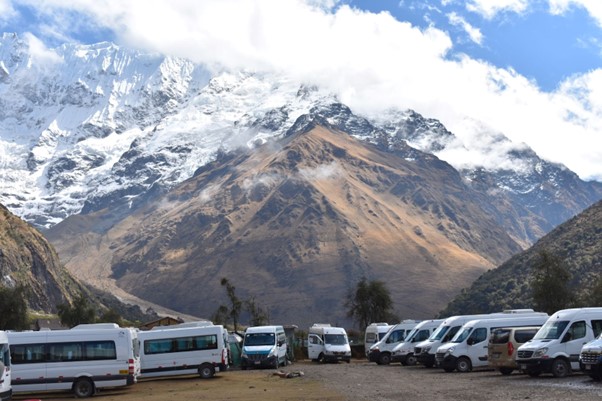
Buses at Soraypampa camp.
Day 2: Soraypampa / Salkantaypampa – Soyrococha – Abra Salkantay / El Passo – Huaracmachay – Colpapampa
- Total trek distance: ~ 22km / 13.67 miles
- Total time walking: ~7 hours
Day two is the longest ascent, so prepare to be challenged.
After waking early, you will begin the trek from Soraypampa / Salkantaypampa to Soyrococha (4,600m / 15,091 ft). This stretch takes about 2-2.5 hours. It starts gradually and gets steeper.
After about an hour of trekking, the trail begins zigzagging. These switchbacks are called the 7 Culebras (7 snakes), making this one of the toughest parts of the trail.
Many guides refer to this section as the ‘Gringo Killer’. Don’t let that scare you! In the cool hours of the morning, the ascent is totally manageable if you take it slow. After my trek, my entire group agreed that the slope was not as difficult as it had been made out to be.
Please Note: There is an option to ride a mule or horse up this section (at an extra cost of 100 soles). If you are already struggling with the altitude, consider taking this ‘mountain taxi’ for the rest of the way up.
At the top of the Culebras, you might notice that the temperature is cooler. Wear a hat and sunscreen as the sun is more intense at this altitude.
The views of Salkantay from here onwards are breathtaking. Make sure you have enough film and battery life. After this, you will reach Soyrococha before 10 am.
You might be exhausted as the air is thin at this altitude. There is still a significant climb ahead, so dig deep in your reserves!
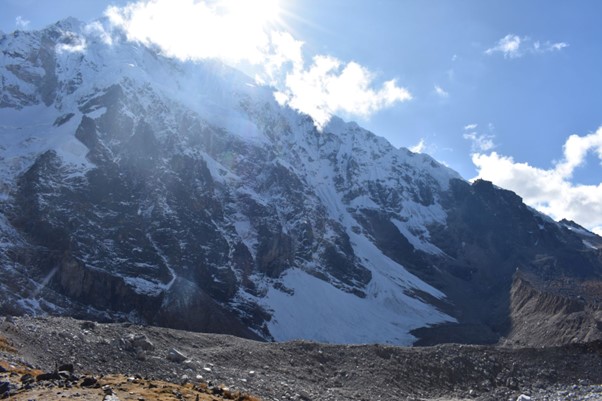
Salkantay Mountain
You will continue for another hour upwards, with Salkantay on your right. Finally, you will reach the Salkantay Pass (4,630m / 15,190 ft). You can enjoy the feeling of immense satisfaction and pride at this exquisite height.
On a clear day, you will get amazing views of Salkantay Mountain to your right and Humantay Mountain (5,917m / 19,413 ft) to your left.
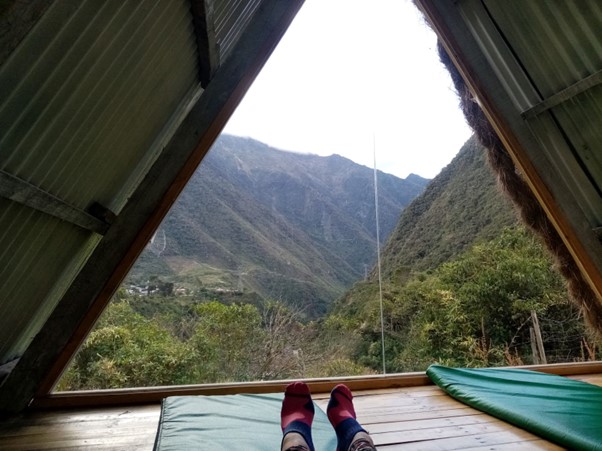
One of many camps at Chaullay. You can enjoy a well-deserved rest here after a mammoth day of trekking!
Here’s the good news. From the Salkantay Pass, it is all downhill. You will descend 2-3 hours to Wayraqmacchay (3,912m / 12,834 ft) for a lunch break. It is possible to stay overnight here. However, most tours continue further for 3 more hours down to Chaullay (2,920m / 9,580 ft) or Collpapampa (2,850m / 9,350 ft).
As you get lower in the valley, you will notice that the landscape changes dramatically. Andean mountain terrain becomes a lush tropical forest.

Get a Salkantay trek quote
Start planning your Machu Picchu hiking holiday.
Day 3: Collpapampa - La Playa
- Total trek distance: ~18km / 11.19 miles
- Total time walking: ~6 hours
Day 3 is considered fairly easy-going. You may even rise later than usual to depart from the campsite at Collpapampa.
There are some ascents at the beginning of the hike. However, most of the trail is along even ground towards Playa Sahauyaco (2,064m / 6,771 ft). The route is a little more populated than the earlier trails. The area sits firmly within the tropical forest zone.
Some friendly advice: douse yourself with insect repellent before you begin hiking. My legs looked like a war-zone, covered with bites from nasty little sandflies.
Playa Sahauyaco is a small campsite bordering the Salkantay River and the Santa Teresa Valley. With that said, it is a lot bigger than any of the other campsites you would have stayed at. For this reason, some trekking companies like to continue on for 30 minutes to Lucmabamba. Other trekkers catch a minibus to Santa Teresa.
You should reach your camp by lunchtime. Some companies include a short coffee tour before or after your meal.
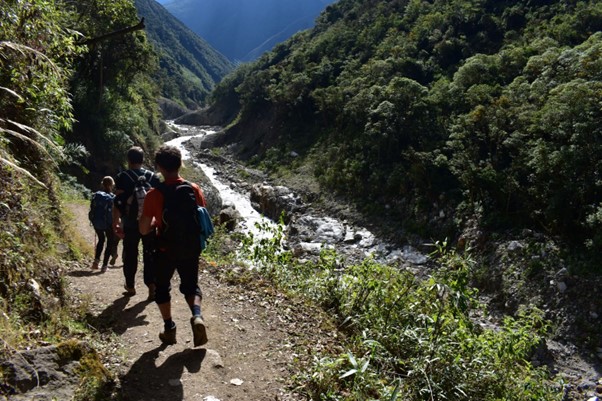
Jungle trail along the river on Day 3 of the Salkantay Trek.
Day 4: La Playa – Hidroeléctrica – Aguas Calientes
- Total trekking distance: ~17 km / 10.56 miles
- Total time walking: ~7 hours
Some companies offer Day 3 activities on the morning of Day 4. After these activities, tour groups are then transported directly to Hidroeléctrica (1,890m / 6,200 ft).
However, it is more common to trek over the mountain on Day 4. You will then arrive at Hidroeléctrica on foot.
Wake up early and hike from Playa Sahauyaco or Santa Teresa through aromatic coffee plantations. This is a long and challenging hike uphill. Some of this trail goes up the original Incan steps.
The views from the lookout points are spectacular and you will see flocks of green parrots along the way.
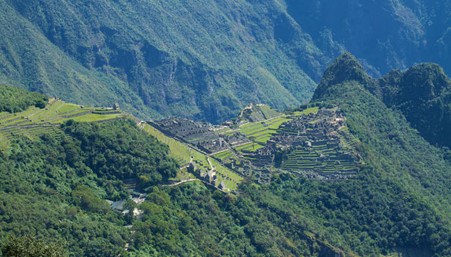
First view of Machu Picchu in the saddle.
It will take you around two hours to reach the viewpoint of Machu Picchu. Do not skip this lookout! You can catch your first glimpse of the ancient city - nestled between the Huayna Picchu and Machu Picchu mountains in the distance.
From the top, it is around 20 minutes down the mountain to the Llactapata Ruins (2,702m / 8,864 ft). The site is still covered by vegetation in some areas. It gives a good sense of what Machu Picchu must have looked like when Hiram Bingham stumbled upon it in 1911.
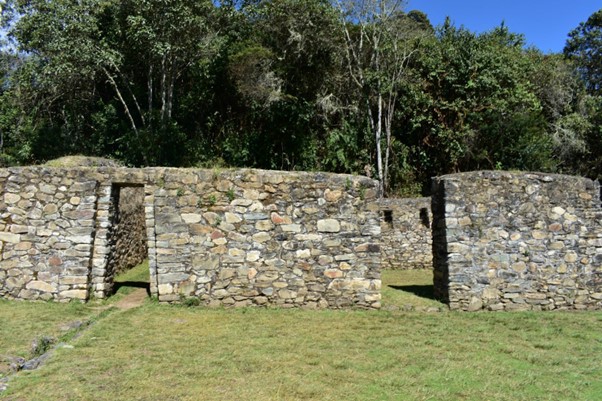
The route descends steeply for 2 hours from the site to the Hidroeléctrica Station.
Here, you will stop for lunch before catching the train (which costs about $25) or trekking another 2-3 hours (10km / 6.2 mi) along the rails to Aguas Calientes.
See more in our guide on how to travel to Machu Picchu.
Where to stay? Here are 5 of my favourite accommodation options in Cusco:
See more Cusco accommodation options.
Day 5: Aguas Calientes – Machu Picchu – Cusco
Aguas Calientes (2,040m / 6,693 ft) is the town that sits below Machu Picchu. You will stay overnight here in a hotel – ah, a real bed and shower! The next morning, you will make your way to Machu Picchu.
See more in our guide on best Machu Picchu hotels in Aguas Calientes.
From Aguas Calientes, there are buses that run regularly up and down between the town and Machu Picchu (2,430m / 7,972 ft).
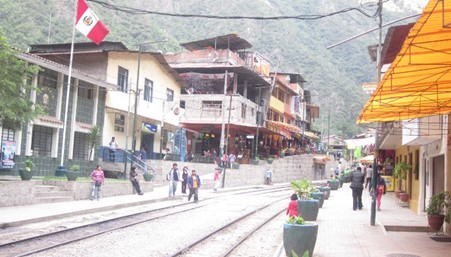
Aguas Calientes, the town below Machu Picchu (often referred to as Machu Picchu town).
The first bus departs around 05:30 and tickets cost about $12 each way. Queues for buses can start before 05:00 during the peak trekking season (May-September), so get there early. A one-way bus trip takes 30 minutes.
It is also possible to walk up to Machu Picchu. This takes a good hour and a half and involves scaling over 1,700 steps!
For many, it is a goal to witness the sunrise from Machu Picchu’s Sun Gate (Inti Punku) situated at 2,730m / 8,956 ft). You will need to get one of the first buses to the Citadel and then briskly walk up the trail leading to the Sun Gate. It is well marked and takes about 45 minutes at a good pace.

The view of Machu Picchu from Inti Punku (the Gate of the Sun).
Please remember your passport and your ticket as you will need them to enter Machu Picchu. If you have booked the Salkantay trek with a company, you will have a 2-hour tour around Machu Picchu with your guide.
After the general circuit, you will have free time to explore Machu Picchu. The route you take depends on your ticket. You may also have booked a hike up one of the mountain viewpoints.
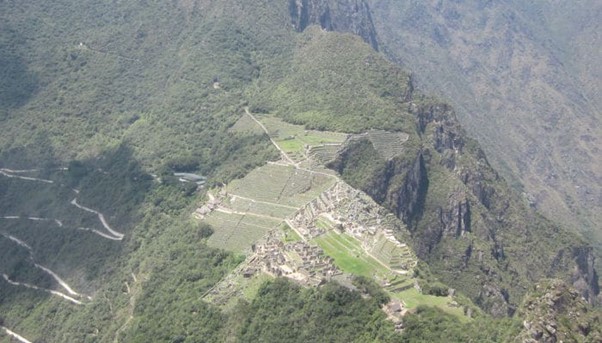
The view of Machu Picchu from Huayna Picchu (aka Wayna Picchu or Wayna Pikchu).
You need to book early if you want to climb Huayna Picchu. Machu Picchu Mountain is less popular but equally challenging. Permits are also required, so make sure you book well in advance.
When you finish exploring Machu Picchu, you can either walk back down to Aguas Calientes (which takes about 1 hour) or catch a bus. Buses depart regularly, but expect queues during and just after lunchtime. This is when most trekkers head back to catch trains to Cusco.
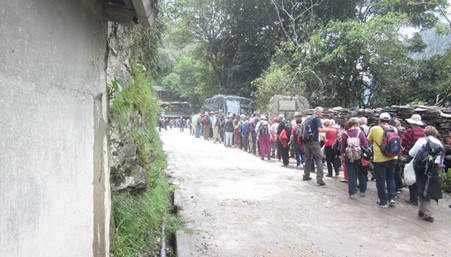
Queues for buses at Machu Picchu start forming around lunchtime and waits can be as long as an hour on bad days.
If you are with an organised tour, you will likely have train tickets booked for Ollantaytambo (2,792m / 9,160 ft). From Ollantaytambo, you will catch a minibus / private car back to Cusco, which takes approximately 1.5 hours.
If your tour doesn’t include the train (i.e., you booked the ‘return by car’ option), you will need to walk back along the rails to Hidroeléctrica. This will take another 2-3 hours.
From Hidroeléctrica, the van ride to Cusco is 7-8 hours with a stop for a snack. I highly recommend taking motion sickness tablets for this windy ride.

Get a Salkantay trek quote
Start planning your Machu Picchu hiking holiday.
Other Things to Do During the Salkantay Trek
Many Salkantay Trek companies also offer additional activity options.
Whether you're looking for adventure or relaxation, there's something for everyone venturing along the Salkantay trek.
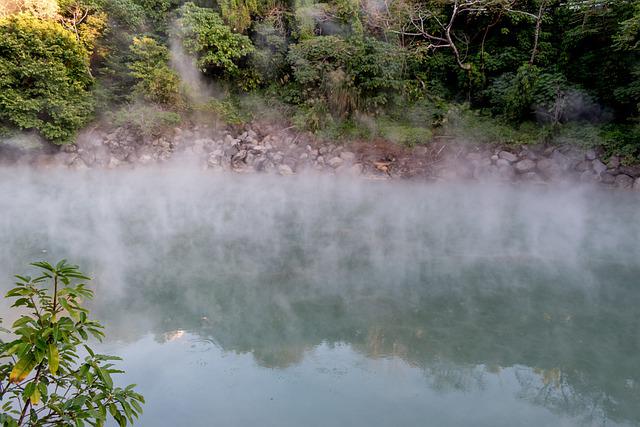
Option 1: Hot Springs in Colcamayu
The first option is the most relaxing. Particularly if you are feeling shattered after 3 days of hiking. A bus will take you to the thermal baths in Colcamayu. This is roughly a 45-minute drive from the town of Santa Teresa.
Spend a few hours soaking your sore muscles whilst enjoying jungle surroundings. You may want to take extra cash for cocktails.
Price Range: ~50 soles / $16 (including transport)
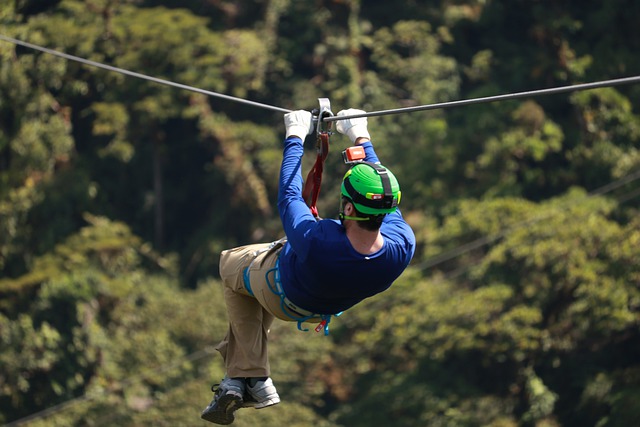
Option 2: Zip-lining at Cola de Mono
This option is for adrenaline-seekers. Trekkers are transported to Cola de Mono, the site of South America’s highest zip-line.
Here you will fly down 5 different lines between 12 platforms. The steel cables are approximately 250 meters (820 feet) above the ground.
Price Range: ~100 soles / $30
What is The Salkantay / Inca Combo?
The Salkantay / Inca Trail Combo combines the best of both worlds. This is where the extraordinary mountain scenery of the Salkantay Trail meets the authenticity of the Classic Inca Trail.
Although the route has a similar first day to the Salkantay Trail, it soon departs from the Classic route by heading east around Salkantay. The route is longer and more challenging than the classic Salkantay trek. It is typically completed on a 7D/6N itinerary. It is sometimes called the 7-Day Inca Trail and requires an Inca Trail permit.
See more in our guide on the full itinerary for the Salkantay-Inca Trail.
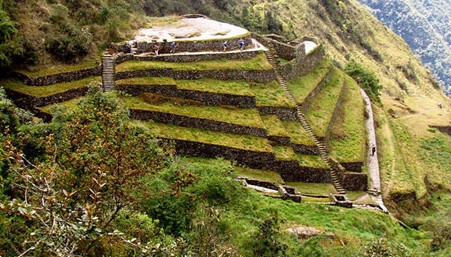
Salkantay Trek Altitude Profile
Here are some more details about the route followed on a typical Salkantay trek. After most trekkers reach Soraypampa, the trail tends to split in western and eastern directions depending on the trekking itinerary.
The Western trail follows the Salkantay trail up and over El Paso and around Playa Sahauyaco. The Eastern trail showcases the Salkantay / Inca Trail Comb trek by climbing over the Incachiriasca Pass to join the Classic Inca Trail at Wayllabamba (3,000m / 9,842 ft).
There are also some excellent route maps available in the Trailblazer Inca Trail Guidebook.
Here is our handy altitude profile for the Salkantay Trek. As you can see below, the first two days are tough. After this, the gradient evens out from Chaullay onwards.
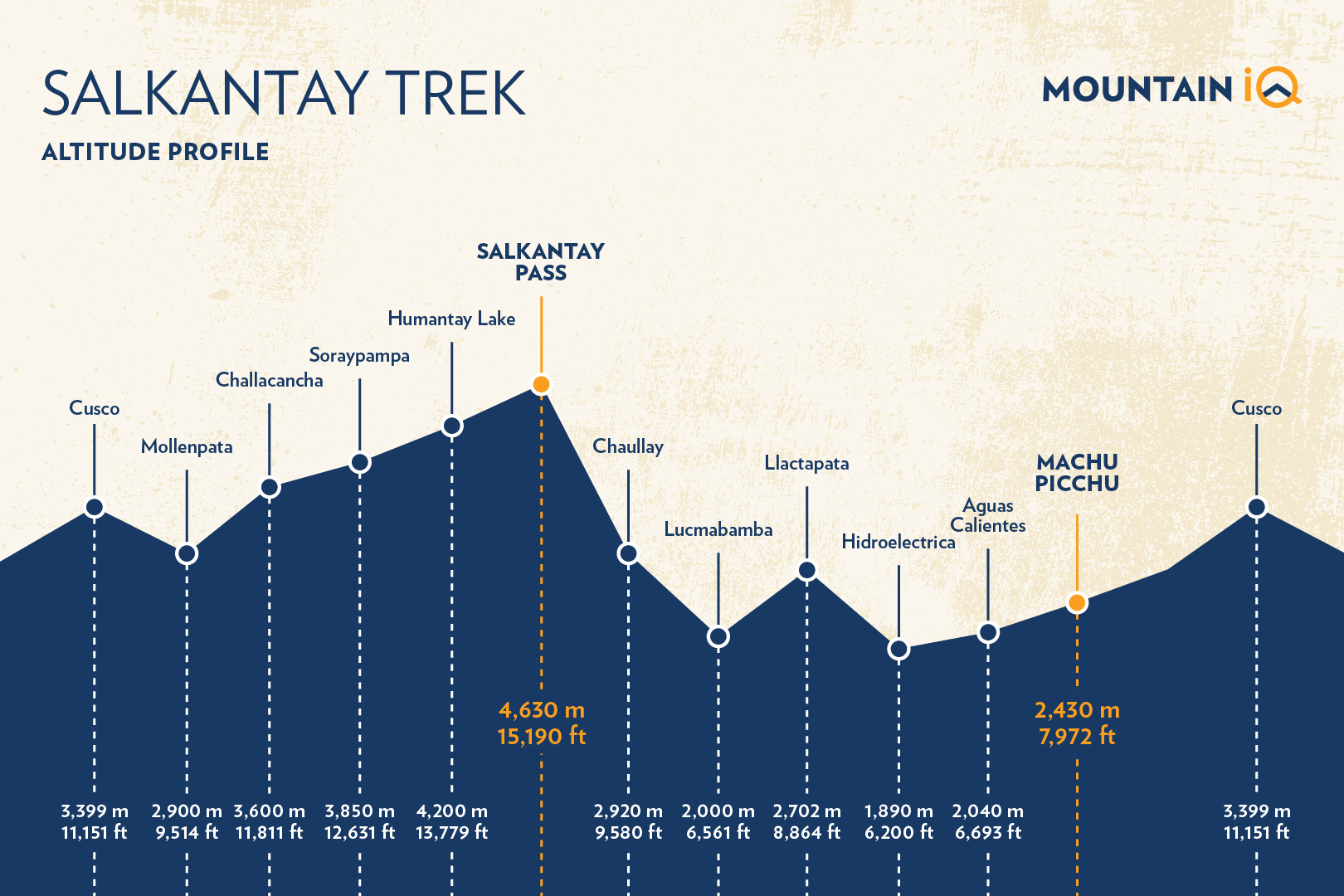
When Is the Best Time to Do the Salkantay Trek?
There are two main seasons in the subtropical Peruvian Andes:
- The dry season, which runs from late April through to early October.
- The wet season, which starts around mid or late October and draws to a close in April.
The peak trekking season to Machu Picchu occurs during the dry season. The Inca Trail is very busy during these months and permits sell out months in advance.
Those who don’t get permits for the Inca Trail typically overflow onto the Salkantay trail or the Lares trail. This means that between May and September, the Salkantay route can be busy.
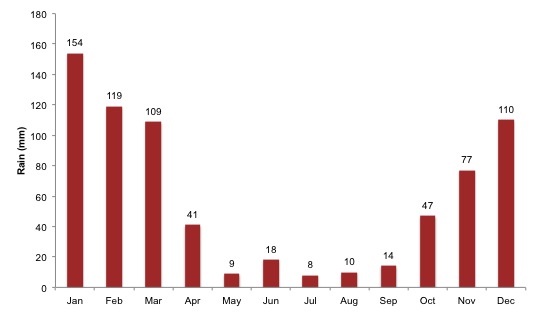
That being said, you will not get a sense of overcrowding which can be the case on the Inca Trail. There are usually around 6 groups (8-20 people each) hiking the trail at a time on the Salkantay. These are spread out as groups start the day at different times and walk at different paces, which still allows you some tranquility during your trek.
Technically speaking, the Salkantay trek can be completed all year round. Although, I highly recommend avoiding the months of December, January, and February. This is when rainy days are the norm, which can make trekking extremely dangerous due to landslide risk.
The best trekking times run from the shoulder wet months (March / April). Good weather continues up to the shoulder dry months (October / November).
Temperatures throughout the year follow a very consistent pattern. The days are warm, reaching the high twenties in Celsius (70-80°F). The nights and early mornings are cold. After dark, temperatures are usually single digits and sometimes go below 0°C (32°F).
Temperature fluctuation is further exacerbated by the dominant micro-climates in the region. The first night is particularly icy below Salkantay Mountain. It gets warmer as you descend into the tropical forest on the following days.
Layering your clothes is key to staying comfortable throughout your trek. See more in our equipment packing list section below for details on ideal clothing requirements for the Salkantay trek.
Full charts on historic weather patterns in and around Machu Picchu can be seen here.
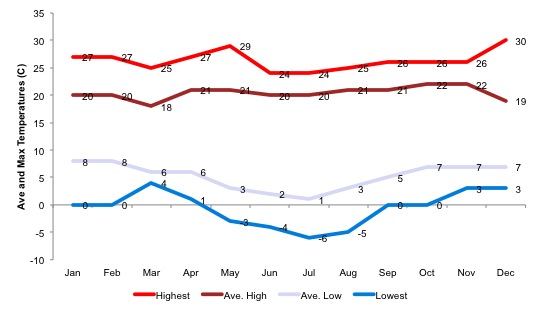
What To Know Before Hiking the Salkantay Trek
Acclimatization and Altitude Sickness on the Salkantay Trek
The Salkantay trek is a high-altitude hike and comes with altitude sickness risks.
The highest altitude that you will reach on this trek is just over 4,600m / 15,092 ft) (4,900m / 16,076 ft if you do the Salkantay / Inca Trail Combo). This might be the highest altitude you have ever gone to outside of an airplane, which is remarkable when you think about it.
At this altitude, available oxygen per breath is nearly 45% less than what is available at sea level. This results in a number of physiological impacts.
It is difficult to predict how a higher altitude will personally affect you. There is very little correlation between altitude sickness symptoms and age, fitness, or gender.
However, we do know that going too high too fast is a key determinant of altitude sickness. Given enough time and adequate spacing, the body can adapt to higher and higher altitudes – this is called acclimatisation.
The trouble with treks to Machu Picchu is that most, if not all trekkers, start their journey from Cusco (3,399m / 11,151 ft). This city is already at a high altitude, making the potential of altitude sickness even greater.
It is important that you spend a few days (2 at a minimum) acclimatising in Cusco. You could also stay in the Sacred Valley before starting your trek. This area is nearly 1,000m / 3,281 ft below Cusco.
See more in our guide on acclimatisation and altitude sickness.
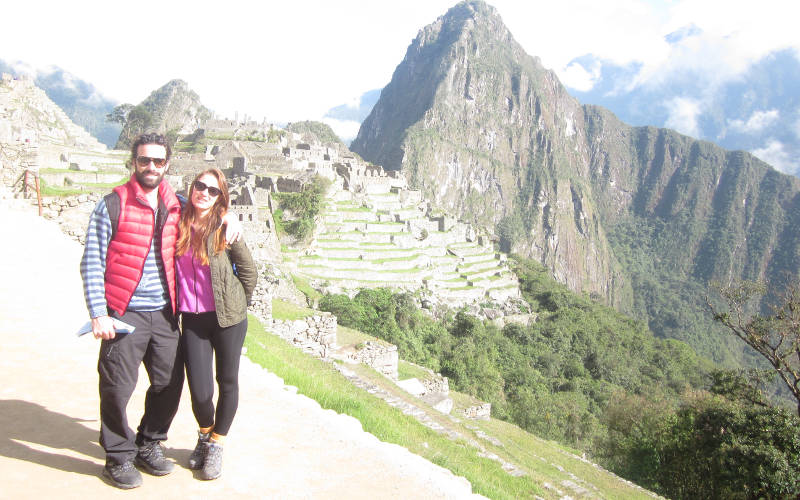
What Do I Pack for the Salkantay Trek?
There are a few key equipment items that you will need to take with you on your Salkantay trek.
I have written a very comprehensive packing list for the Inca Trail. This checklist is identical to what is needed for the Salkantay trek.
The only key difference is that mules are used to carry gear on the Salkantay trek instead of porters like on the classic Inca Trail.
The weight distribution between porters and mules is very similar. You will be given a tog bag and allowed to pack up to 5kg / 11 lbs. (7kg / 15.4 lbs. including a sleeping bag).
Basically, you will be packing a few changes of clothes and your toiletries. Include a small towel and warm layers for the evenings.
During the day, you will be carrying a daypack. This should contain your waterproof jacket, camera, snacks, hat, sunscreen, and other essentials.
Please Note: Don't pack anything delicate as the bags get fastened onto the mules and your items could be crushed.
Do I Need to Train for the Salkantay Trek?
The Salkantay trek is a moderate to tough hike, so you don’t need to be super-fit or a marathon runner. However, you should be in relatively good shape all the same. It will help to train for a few months before arriving in Cusco.
The best type of training you can do is aerobic cardiovascular exercise. This includes long-distance jogging, swimming, or cycling. Click here to read our hiking training program. This provides some useful guidance on how best to prepare for the Salkantay trek.
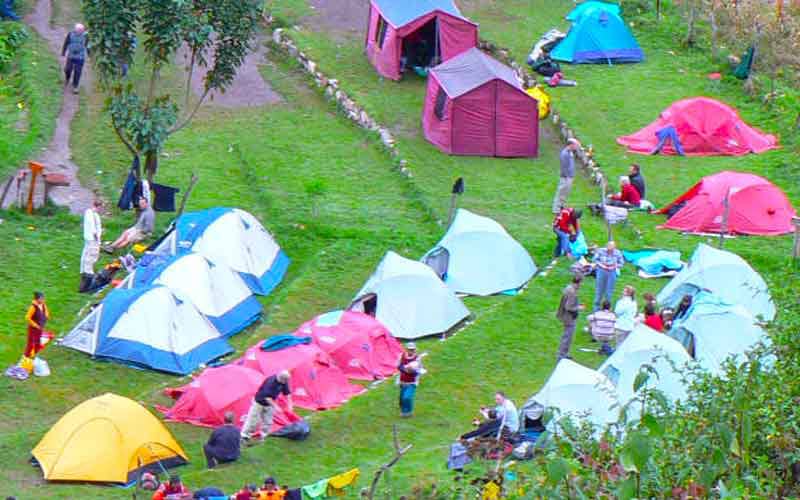
Are There Toilets and Showers On The Salkantay Trek?
The Salkantay Trek goes through small villages and rural areas. Along the way, at regular intervals, you will find flushing toilets that you can pay 1 sole to use. Most of these bathrooms are fairly clean but don’t expect to find toilet seats or toilet paper. Be sure to pack a toilet roll in your backpack.
There are showers at almost every camp, particularly as you head towards Machu Picchu. Most of these are fairly basic and only have cold water. At some campsites, it is possible to pay up to 10 soles to have a hot shower.
Where to stay? Here are 5 of my favourite accommodation options in Cusco:
See more Cusco accommodation options.
Is There Drinking Water On The Salkantay Trek?
It is not advisable to drink water along the trail. Rivers in this area pass through communities and there are many animals around. It’s better to be safe than sorry with drinking water on the Salkantay Trek.
If you have booked with a more expensive tour company, the chefs will boil water to refill your bottles each day. Budget Salkantay companies do not provide water.
You will have loads of opportunities to buy bottles of water at camps and along the trail. However, these are sold with a huge markup. A 1-litre bottle of water will cost between 6-10 soles. This adds up quickly if you are traveling on a tight budget.
I recommend being prepared and bringing a water bottle with a filter attached. Purification tablets are usually okay but are not 100% effective in every case, making filters more reliable.
Either way, fill up your bottle from high in the catchment or where the water is clean and flowing well. Never take water from below houses or where grazing animals are located.
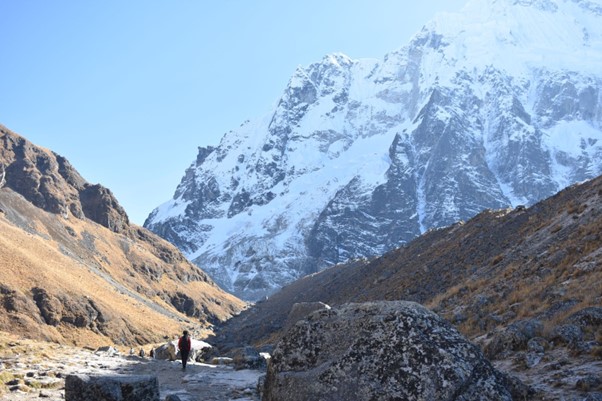
How Much Does The Salkantay Trek Cost?
Like most treks to Machu Picchu, the costs vary quite dramatically. Here is a brief overview of the types of operators you will come across and their prices:
- Local Operators: $250-600 per person
- International Trek Operators: $400-$700 per person
- Private / Luxury Salkantay Treks: $800-$2000 per person
When it comes to local operators, it is important to note the quality of treks. There are huge variations in terms of service, equipment, guiding, facilities, and safety.
There are over 200 local trekking companies in Cusco alone. Generally, they are split into two types:
- Cheap local operators
- Responsible local operators

Get a Salkantay trek quote
Start planning your Machu Picchu hiking holiday.
Cheap Local Operators
At the bottom of the market are the cheap local operators. These guys often cut corners and pay questionable wages to their staff. Their services often don’t stack up to their promises.
Cheap operators base prices on large groups of up to 16 trekkers. If they don’t reach this number, they will combine treks with another company.
Booking with a cheap operator doesn’t necessarily mean that you will have a bad experience. But the likelihood of poor service is much higher. If it sounds too good to be true, it probably is.
Prices for this type of operator often exclude certain key tour items. Usually, these are the bus tickets to Machu Picchu and return train tickets. Make sure you check what is included beforehand.
Looking for a day tour? Here are my 5 favourite day tours around Cusco:
- Rainbow Mountain day trip (with meals)
- Moray and Salt Mines Quad Bike Tour
- Sacred Valley day tour
- Humantay Lake day tour
- Machu Picchu and Huayna Picchu entrance tickets
See more Cusco day trips.
Responsible Local Operators
There are a number of great local trekking companies. These companies offer excellent services and run responsible operations.
Finding a responsible trekking company for the Salkantay Trail can be tough. I have picked out some of my favourite Salkantay trekking companies.
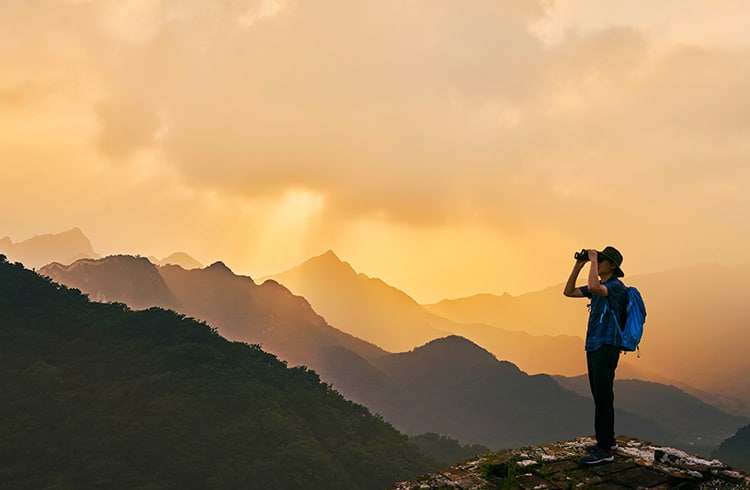
Do You Need Insurance For The Salkantay Trek?
Insurance for your trek to Machu Picchu is a must. Most operators will require you to carry sufficient travel insurance for your trek.
As most trails to Machu Picchu go over high 4,000m / 13,123 ft passes, you will need to make sure your insurance covers you for high-altitude hiking (up to 6,000m / 19,685 ft).
We have reviewed a number of travel insurance providers and the most affordable and best by far is Rise & Shield.

Get a Salkantay trek quote
Start planning your Machu Picchu hiking holiday.
Conclusion
I hope that I have answered many of your questions about the Salkantay trek. If you have any unanswered questions, please leave a comment below and we will respond within 24 hours.
Please feel free to share this page with friends and family or link to it from your blog. We always appreciate a shout-out on your social media page!
We very much welcome questions or feedback so that we can keep this article up to date. Thanks!
Tags: Salkantay Trek, Salkantay Trail, Salkantay Trekking, Salkantay Trek to Machu Picchu, Salkantay Trek Peru, Camino Salkantay, Salkantay Pass, Salkantay Peru, Salkantay Trail Peru, Salcantay trail

Wow ! All great information ! Do I nedd to make some camp site reservation if i'll like to hike de Salkantay by my own? For a first experience, do you recommed with a guide tour or I can organise everything by my own? Thnaks
Hi Odrey, you are most welcome! From my experience, camp site reservations are not usually necessary. However, this trail gets busier every year and things change. If you can track down a number for camping/ accommodation, I’d say try to call. Of course you can do it on your own (it’s very manageable and the trail is easy enough to follow) but I sometimes find it’s nice to hike with a group. The social aspect is fun plus it takes away all the stress of planning. It’s up to you and depends on your travel style but, if it’s your first multi-day trek and you don’t speak any Spanish, I’d lean towards the guided option. If you do want to enquire about guided trips, I’d recommend checking out Skyhook Adventures. Hope that helps!
Hi Alison, you've written a great blog about the Salcantay trail! So very helpful! Such a gift! A couple of questions: I'm 66, in shape but no marathoner, and am wondering if I'm a suitable candidate for this hike? I'm thinking of taking the 8 day Cusco & Salkantay Trekking to Machu Picchu with your recommended outfit, Inkayni travel. An ignorant question: how do I dial their number from the US (California)? Thank you so much! Lori
Hi Lori
Thank you so much for the response. I’m glad to know the info is useful!
Yes, you are absolutely OK to do this hike. Just be sure to spend a few days in Cusco acclimatizing to the altitude. Also, take it easy and drink lots of water and coca tea. I suffered a bit from altitude sickness on one of my early hikes in Peru, it doesn’t discriminate by age and fitness level!
I have personally never tried dialing Peru from the USA but I believe you need to Dial 011 51 933 839 757. Hopefully that works.
Have an amazing trip!
Hi! Great article!
I’m thinking think to travel to Peru in mid March-April or in November, since I work from May to October. What do you think is a better month for trekking? I’ve seen the ‘rain’ chart and it seems that April would be my best option; but, in terms of landscape, do you think it will be nicer in April, after rain season, or in November, after dry season? Also, I would like to leave my backpack in Cuzco so I don’t have to carry too much weight during the trail, do you think this is possible?
Thank you very much!
Hi Alex, I would go in April, this is a better month than March – weather-wise – and the scenery is great too. In terms of your backpack, almost all hotels offer a storage facility for hikers so you shouldn’t have a problem leaving it in Cusco. All the best!
I found this and the initial article re the Salcantay walk exceptionally good and informative, and clarified a great deal. I am in my early sixties fit and have hiked in NZ and Nepal, and would loke to trek in south America , the Salkanty, and the O or W track in Chile, and this article was very encouraging in respect to my aspiration to trek solo or at least independently of a tour group. I'm also trying to marry this up, no pun intended with travelling with my wife who is no so keen on extended day treks . Could she possibly take the train to Aguas Calientes, so we could do the last part of the trek to Machu Pichu together , then travel back together on the train/bus ?
Hi Warren, thanks for your kind feedback. Yes, your wife could take the train to Aguas Calientes to meet you. She’ll obviously need to hang around Cusco for 3-4 days whilst you hike the Salkantay. From Aguas Calientes it’s a relatively short and easy walk up to Machu Picchu. Most people take a bus for this section, but you and your wife could easily walk. You’ll probably want to stay the night in Aguas Calientes on the day of arrival and then hike up to Machu Picchu, do a guided tour and then get a train back. Hope this helps!
Hi!
I’m currently looking into doing the Salkantay trek at either half November or half December (around the 15th). I will be in Peru from the beginning of next week, so I could fly from Lima to Cuzco and do this trek at the beginning of my trip. Or, I will end with it, after traveling around for four months. I’m very worried about the weather in December, but on the other hand don’t know if it is “smart” to start Peru with the Machu Picchu (because of the altitude). Furthermore, I don’t know if there are any tickets still available.
What is your opinion?
Hoping to hear from you and thank you for your time.
Hi Noa, The weather can be quite unpredictable in December – usually there is quite a bit of rain, but you may get a glorious week. The altitude risk is really highest in Cusco. I recommend spending a few days relaxing in Cusco or the Sacred Valley before hiking the Salkantay – that way you can pre-acclimatise for the Saklkantay pass, which is the highest altitude you will reach. You should still be able to secure Machu Picchu entrance tickets – but worth checking with a few operators now instead of booking last minute.